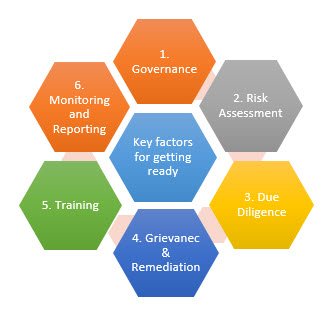Modern Slavery Report

YOUR COMPANY MAY NEED TO PROVIDE A MODERN SLAVERY STATEMENT AS A MATTER OF LEGISLATED COMPLIANCE REQUIREMENTS. ARE YOU COMPLIANT?
Who is required to report?
The Modern Slavery Act 2018 (Cth) (“Act”) requires that an entity that has an annual consolidated revenue of at least AUD 100 million, and is either an Australian entity or a foreign entity carrying on business in Australia, (pursuant to section 21 of the Corporations Act 2001), must prepare a Modern Slavery Statement (“Reporting Entity”).
Timelines for annual reporting
Entities will have different reporting due dates depending on their financial years. The due dates for each financial period are outlined in the table below.
| Entity’s financial year | First reporting period under the Act | Due date for Statement |
|---|---|---|
| Foreign Financial Year e.g. UK and Japan (1 April – 31 March) | 1 April 2019 – 31 March 2020 | No later than 30 September 2020 |
| Australian Financial Year (1 July – 30 June) | 1 July 2019 – 30 June 2020 | No later than 31 December 2020 |
| Calendar Year (1 January – 31 December) | 1 January 2020 – 31 December 2020 | No later than 30 June 2021 |
What do you have to report?
You must show the action you have taken to assess and address the risks of modern slavery in your operations and supply chains, and the effectiveness of your plan. The statement has to be approved by the board of directors or equivalent and signed by a director.
Your Modern Slavery Statement must address the following mandatory criteria:
1. Identify the reporting entity (your company);
2. Describe the structure, operations and supply chains of the reporting entity;
3. Describe risks of modern slavery to the entity and entities which the reporting entity owns or controls;
4. Describe actions taken to assess and address risks;
5. Describe how the effectiveness of the actions taken to address risks are assessed;
6. Describe the process of consultation with entities the reporting entity owns or controls; and
7. Any other information that the reporting entity considers relevant.
Key factors to consider when preparing your Modern Slavery Statement

For each of the above factors, you must address the following:
1. Governance
• Do you have a mapping of the broad operations and overall supply chain structure of your entity?
• Have you identified the general sectors and industries, types of products and services, countries and entities that are involved in your entity’s operations and supply chains?
• Have you determined which entities and investments in your corporate group will be included in your Modern Slavery Statement?
2. Risk Assessment
• Have you identified which sector, types of products and services, countries and entities may involve high modern slavery risks?
• Have you carried out the assessments on the likelihood of an occurrence, the severity of impact on the individual and your business’ leverage to create change?
3. Due Diligence
• Have you got an assessment / due diligence process in place for screening or engaging your suppliers?
• Do your suppliers understand their Modern Slavery obligations and your expectations of them? Have you embedded ongoing due diligence and oversight of Modern Slavery risk in the standard supplier management processes (e.g. news alerts, notifications of country changes or material changes in their supply chain etc?)
• Have you added Modern Slavery risk reviews into your supplier site visit procedures?
• Have you reviewed / updated your existing contracts, polices, codes of conduct? Do you require new policies, procedures and codes of conduct to be drafted?
4. Grievance and Remediation
• Have you established a clear grievance channel, i.e. a whistle-blower mechanism to allow people within your organisation to safely report modern slavery risks?
• Do you have a defined strategy for responding to any identified Modern Slavery Risks?
5. Training
• Are your staff and suppliers educated and trained on what modern slavery is, what circumstances may be a risk and how to report any potential issues?
• Have you developed a tailored training and educational materials for your boards, staff and suppliers?
6. Monitoring and Reporting
• Do you have an established internal and external reporting channels for ongoing monitoring and reporting on modern slavery risk management?
• Have you explored any mechanisms to measure the effectiveness of actions you undertake to address modern slavery risks?
Suggested Table of Contents
By considering the key factors outlined above, your Modern Slavery Statement will include the following contents:
| TABLE OF CONTENTS |
|---|
| 1. Introduction – Your Business |
| 2. Organisational Structure |
| 3. Governance Framework |
| 4. Identifying your Supply Chain |
| 5. Supplier Governance Framework |
| 6. Risk management and Due Diligence |
| 7. Grievance Mechanisms |
| 8. Training |
| 9. Reporting and Performance Indicators |
Consequences of Non-Compliance
The Minister of the Australian Border Force has the power to issue a written request if an entity fails to prepare a Modern Slavery Statement within the reporting period. The failure to respond to the request does not attract a penalty, however the Minister has the power to name and shame the entity and provide details of its non-compliance to the public, creating a significant risk in terms of reputational damage globally.
Need assistance?
Please contact our office if you would like our assistance with preparing a compliant and comprehensive Modern Slavery Statement.
Contributing Advisors

